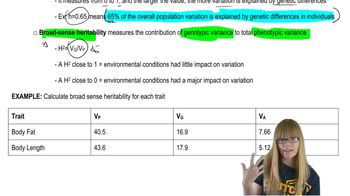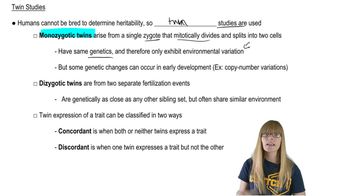20. Quantitative Genetics
Heritability
Practice this topic
- Multiple Choice
A chicken breeder has a population of chickens where the average number of eggs laid per hen per month is 34. The narrow-sense heritability is 0.75. With this information is it likely that a breeder could select for an increase in eggs per hen laid each month?
- Multiple Choice
The narrow-sense heritability of the number of seeds per flower is 0.9. The mean of the population is 6.0 seeds per flower. A flower breeder crosses one flower with 7 seeds to another plant with 9 seeds. What is the expected number of seeds per flower in the offspring of this cross?
- Multiple Choice
Heritability calculations were calculated for a variety of different traits. Which of the following traits would respond best to selection?
- Open Question
In this chapter, we focused on a mode of inheritance referred to as quantitative genetics, as well as many of the statistical parameters utilized to study quantitative traits. Along the way, we found opportunities to consider the methods and reasoning by which geneticists acquired much of their understanding of quantitative genetics. From the explanations given in the chapter, what answers would you propose to the following fundamental questions:
How do we know that monozygotic twins are not identical genotypically as adults? - Open Question
Define the following: (a) polygenic, (b) additive alleles, (c) correlation, (d) monozygotic and dizygotic twins, (e) heritability, (f) QTL, and (g) continuous variation.
- Open Question
Erma and Harvey were a compatible barnyard pair, but a curious sight. Harvey's tail was only 6 cm long, while Erma's was 30 cm. Their F₁ piglet offspring all grew tails that were 18 cm. When inbred, an F₂ generation resulted in many piglets (Erma and Harvey's grandpigs), whose tails ranged in 4-cm intervals from 6 to 30 cm (6, 10, 14, 18, 22, 26, and 30). Most had 18-cm tails, while 1/64 had 6-cm tails and 1/64 had 30-cm tails. If one of the 18-cm-tail F₁ pigs is mated with one of the 6-cm-tail F₂ pigs, what phenotypic ratio will be predicted if many offspring resulted? Diagram the cross.
- Open Question
Erma and Harvey were a compatible barnyard pair, but a curious sight. Harvey's tail was only 6 cm long, while Erma's was 30 cm. Their F₁ piglet offspring all grew tails that were 18 cm. When inbred, an F₂ generation resulted in many piglets (Erma and Harvey's grandpigs), whose tails ranged in 4-cm intervals from 6 to 30 cm (6, 10, 14, 18, 22, 26, and 30). Most had 18-cm tails, while 1/64 had 6-cm tails and 1/64 had 30-cm tails. Explain how these tail lengths were inherited by describing the mode of inheritance, indicating how many gene pairs were at work, and designating the genotypes of Harvey, Erma, and their 18-cm-tail offspring.



